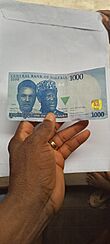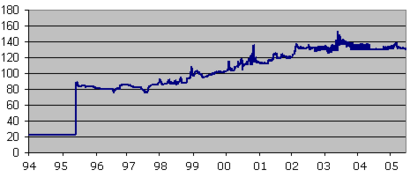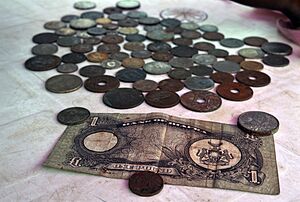Nigerian naira facts for kids
Quick facts for kids Nigerian naira |
|||
|---|---|---|---|
|
|||
| ISO 4217 Code | NGN | ||
| User(s) | |||
| Inflation | 28. 9% | ||
| Source | January 2024 | ||
| Subunit | |||
| 1⁄100 | kobo | ||
| Symbol | ₦ | ||
| Plural | naira | ||
| kobo | kobo | ||
| Coins | 50 kobo, ₦1, ₦2 | ||
| Banknotes | ₦5, ₦10, ₦20, ₦50, ₦100, ₦200, ₦500, ₦1000 | ||
| Printer | Nigerian Security Printing and Minting Company Limited | ||
The Naira (sign: ₦; code: NGN) is the official money used in Nigeria. One Naira is made up of 100 smaller units called kobo.
The Central Bank of Nigeria (CBN) is the only group allowed to print and give out money in Nigeria. They control how much money is in the country. This helps keep prices stable. The CBN also designs, prints, and distributes all the banknotes and coins.
In February 2023, Nigeria faced a big problem with cash. The government changed the design of the banknotes. But they didn't put enough new notes into circulation. This made it hard for people to get cash. It also caused many street protests.
Contents
History of the Naira
The Naira was first used on 1 January 1973. It replaced the old Nigerian pound. One Nigerian pound was worth two Naira. The coins introduced with the Naira were the first coins made by an independent Nigeria. Before this, all coins had Queen Elizabeth II's name on them. Nigeria was the last country to switch from the old "pound, shilling, pence" money system to a decimal system.
The name "Naira" was created from the word "Nigeria." This idea came from Obafemi Awolowo. However, the Naira currency was officially launched by Shehu Shagari. He was the finance minister in 1973.
The Central Bank of Nigeria tries to keep prices from rising too fast. This is called controlling inflation. In 2016, the Naira's value was allowed to change freely. Before that, it was fixed at about ₦197 to one US dollar.
In October 2021, Nigeria launched the eNaira. This is a digital version of the country's money. President Muhammadu Buhari officially started it.
In January 2023, there was a big shortage of Naira cash. This happened because the government wanted people to use new banknotes. They hoped this would stop people from buying votes in the 2023 Nigerian elections. This caused many protests. Later, Nigeria's highest court said the old notes were still legal to use.
The Naira's value has changed a lot. On 14 June 2023, it dropped by 23% in one day. It went from about ₦460 to ₦600 for one US dollar. This happened because the central bank stopped fixing its value. By July 2023, it fell to a new low of ₦853 per US dollar. In early 2024, its value dropped even more, reaching ₦1,400 to ₦1,600 per US dollar.
Naira Coins
In 1973, coins were made in different values. These included 1⁄2, 1, 5, 10, and 25 kobo. The 1⁄2 and 1 kobo coins were made of bronze. The higher values were made of a metal called cupro-nickel. The 1⁄2 kobo coin was only made in 1973.
In 1991, smaller coins were released. These included 1, 10, and 25 kobo coins. They were made of copper-plated steel. Also, 50 kobo and ₦1 coins were made of nickel-plated steel.
On 28 February 2007, new coins came out. These were 50 kobo, ₦1, and ₦2. The ₦1 and ₦2 coins were made of two different metals. The central bank stopped using the 1⁄2 to 25 kobo coins after 28 February 2007.
- 1 kobo
- 5 kobo
- 10 kobo
- 25 kobo
- 50 kobo
- 1 naira
- 2 naira
Naira Banknotes
On 1 January 1973, the Central Bank of Nigeria started using banknotes. These were for 50 kobo, ₦1, ₦5, ₦10, and ₦20. In April 1984, the colors of all Naira banknotes were changed. This was done to help stop illegal money activities.
In 1991, ₦50 notes were introduced. The 50 kobo and ₦1 notes were replaced by coins that same year. Later, higher value notes were added:
- ₦100 in 1999
- ₦200 in 2000
- ₦500 in 2001
- ₦1,000 on 12 October 2005
On 28 February 2007, new versions of the ₦5 to ₦50 banknotes were released. Some of these notes, like the ₦20, were made of polymer plastic. This makes them last longer. In 2009, the ₦5, ₦10, and ₦50 notes were also changed to polymer.
The ₦1,000 notes have special features to stop fake money. There's a shiny strip on the back. A triangle shape on the front changes color from green to blue when you tilt it. The front of the note shows pictures of Alhaji Aliyu Mai-Bornu and Dr. Clement Isong. They were both past governors of the Central Bank of Nigeria.
In 2012, the Central Bank of Nigeria thought about making a new ₦5,000 note. They also planned to turn the ₦5, ₦10, ₦20, and ₦50 notes into coins.
In 2014, the Central Bank of Nigeria released a special ₦100 note. This celebrated 100 years of Nigeria's existence. It looks similar to the regular ₦100 note. It has a picture of Chief Obafemi Awolowo. But it has new colors and security features. It also has a QR code on the back. If you scan it, it takes you to a website about Nigeria's history.
In 2019, something important happened. The Naira notes featured the signature of Priscilla Ekwere Eleje. She was the first woman to be the Director of Currency operations at the Central Bank of Nigeria.
| Currently circulating banknotes | |||||||||
|---|---|---|---|---|---|---|---|---|---|
| 1999–2005 series | |||||||||
| Image | Value | Dimensions | Main colour | Description | Date of | ||||
| Obverse | Reverse | Obverse | Reverse | Watermark | First printing | Issue | |||
| [1] | ₦100 | 151 × 78 mm | Purple and multicolour | Chief Obafemi Awolowo | Zuma Rock | As portrait(s), "CBN", value | 1999 | 1 December 1999 | |
| [2] | ₦200 | Cyan and multicolour | Sir Ahmadu Bello | Pyramid of agricultural commodity and livestock farming | 2000 | 1 November 2000 | |||
| [3] | ₦500 | Blue and multicolour | Dr. Nnamdi Azikiwe | Off-shore oil rig | 2001 | 4 April 2001 | |||
| [4] | ₦1000 | Brown | Alhaji Aliyu Mai-Bornu, Dr. Clement Isong | CBN's corporate headquarters in Abuja | 2005 | 12 October 2005 | |||
| 2006 series (paper and polymer banknotes) | |||||||||
| ₦5 | 130 × 72 mm | Brown | Alhaji Abubakar Tafawa Balewa | Nkpokiti dancers | Central Bank of Nigeria logo, "CBN" | 2006 | 28 February 2007 | ||
| ₦10 | Red | Alvan Ikoku | Fulani milk maids | ||||||
| ₦20 | Green | General Murtala Mohammed | Ladi Kwali | ||||||
| ₦50 | Blue | Hausa, Igbo and Yoruba men and a woman | Local fishermen | ||||||
| For table standards, see the banknote specification table. | |||||||||
Redesign of the Naira in 2022
In 2022, the Central Bank of Nigeria decided to redesign the Naira banknotes. This was done to fight against fake money. The CBN Governor, Mr. Godwin Emefiele, said that President Muhammadu Buhari approved this change. It was also meant to help fight corruption and other illegal activities. They focused on the ₦200, ₦500, and ₦1,000 notes. These were often used by criminals.
President Muhammadu Buhari officially showed the new notes to the public. It had been 19 years since the Naira was last redesigned. The new notes were planned to be printed by a Nigerian company. This makes Nigeria one of the few African countries that print their own money.
In November 2022, the CBN announced that the new notes would be available from 15 December 2022. They also said that old Naira notes needed to be returned to banks by 31 January 2023. After that date, the old notes would no longer be valid. The deadline was later moved to February 2023.
This redesign caused some problems. There weren't enough new banknotes at ATMs. People had to wait in long lines to get cash.
| Currently circulating banknotes | |||||||||
|---|---|---|---|---|---|---|---|---|---|
| 2022 Redesign | |||||||||
| Image | Value | Dimensions | Main colour | Description | Date of | ||||
| Obverse | Reverse | Obverse | Reverse | Watermark | First printing | Issue | |||
| ₦200 | 151 × 78 mm | Pink | Sir Ahmadu Bello | Pyramid of agricultural commodity and livestock farming | As portrait(s), "CBN", value | 2022 | 2022 | ||
| ₦500 | Green | Dr. Nnamdi Azikiwe | Off-shore oil rig | 2022 | 2022 | ||||
 |
₦1000 | Blue | Alhaji Aliyu Mai-Bornu, Dr. Clement Isong | CBN's corporate headquarters in Abuja | 2022 | 2022 | |||
Naira Exchange Rates
The exchange rate tells you how much one currency is worth compared to another. The official rate for the Naira to the US dollar is about ₦767.54 for every 1 US dollar. However, there is also a "black market" rate, which is often different.
According to a recent report, the black market exchange rate for the Naira to the US dollar is around ₦1483 for every 1 US dollar. This big difference shows some of the money challenges Nigeria faces.

This table shows how many Nigerian Naira you needed to get one US dollar over the years. "PM" means "parallel market" or "black market."
| Date | ₦ per US$ | Date | ₦ per US$ | Date | ₦ per US$ | ||
|---|---|---|---|---|---|---|---|
| 1972 | 0.658 | 1993 | 17.30 (21.90 PM) | 2014 | 170–199 | ||
| 1973 | 0.658 | 1994 | 22.33 (56.80 PM) | 2015 | 199–300 | ||
| 1974 | 0.63 | 1995 | 21.89 (71.70 PM) | 2016 | 390–489 | ||
| 1975 | 0.616 | 1996 | 21.89 (84.58 PM) | 2017 | 333 | ||
| 1976 | 0.62 | 1997 | 21.89 (84.58 PM) | 2018 | 360 | ||
| 1977 | 0.647 | 1998 | 21.89 (84.70 PM) | 2019 | 305 | ||
| 1978 | 0.606 | 1999 | 21.89 (88–90 PM) | 2020 | 361 | ||
| 1979 | 0.596 | 2000 | 85.98 (105.00 PM) | 2021 | 399 | ||
| 1980 | 0.550 (0.900 PM) | 2001 | 99–106 (104–122 PM) | 2022 | 423 | ||
| 1981 | 0.61 | 2002 | 109–113 (122–140 PM) | 2024 | 1483 | ||
| 1982 | 0.673 | 2003 | 114–127 (135–137 PM) | ||||
| 1983 | 0.724 | 2004 | 127–130 (137–144 PM) | ||||
| 1984 | 0.765 | 2005 | 132–136 | ||||
| 1985 | 0.894 (1.70 PM) | 2006 | 128.50–131.80 | ||||
| 1986 | 2.02 (3.90 PM) | 2007 | 120–125 | ||||
| 1987 | 4.02 (5.90 PM) | 2008 | 115.50–120 | ||||
| 1988 | 4.54 (6.70 PM) | 2009 | 145–171 | ||||
| 1989 | 7.39 (10.70 PM) | 2010 | 148.21–154.8 | ||||
| 1990 | 7.39 (10.70 PM) | 2011 | 151.05–165.1 | ||||
| 1991 | 8.04 (9.30 PM) | 2012 | 155.09–161.5 | ||||
| 1992 | 9.91 | 2013 | 153.21–162.9 |
| Current NGN exchange rates | |
|---|---|
| From Google Finance: | AUD CAD CHF EUR GBP HKD JPY USD EUR JPY USD |
| From Yahoo! Finance: | AUD CAD CHF EUR GBP HKD JPY USD EUR JPY USD |
| From XE.com: | AUD CAD CHF EUR GBP HKD JPY USD EUR JPY USD |
| From OANDA: | AUD CAD CHF EUR GBP HKD JPY USD EUR JPY USD |
| From fxtop.com: | AUD CAD CHF EUR GBP HKD JPY USD EUR JPY USD |
See also
 In Spanish: Naira para niños
In Spanish: Naira para niños
- Economy of Nigeria



